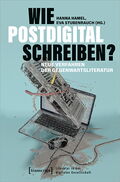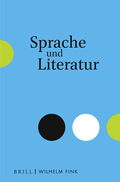
Neighborhood in Contemporary Berlin Literature
Today’s ubiquitous digital interconnectedness brings about new forms of intimacy and distance. Not only do they transform social interactions in the neighborhood, they also change existing ways of producing and perceiving literature. Authors and audiences can now come together not only at readings but also online. Social media’s “new neighborhoods” generate their own forms of exchange such as feedback loops or the mixing of roles of readers, authors, or non-human actors such as platform algorithms. Furthermore, they create overlaps between political, private, and literary expressions that create new challenges for criticism and literary studies.
By analyzing these developments under the aspect of “Nachbarschaften” (“neighborships”), this project aimed to identify and describe the new relations in which texts and creators of literature have to currently situate themselves. The changing forms and formats of production, distribution, and reception were as important to the project as were the new practices of cooperation, solidarity, identity, belonging, and distinction—concepts which contemporary literature not only treats in its texts but that are also politically relevant in this context as they change both the mechanisms of the literary scene as well as its local structures.
The project was both a research and a transfer project. The public dialogue with literary creators and scholars in and from Berlin and the cooperation with local cultural and research institutions were essential parts of this work. Transfer took place in both directions: on the one hand, research questions and topics were presented to an interested public. On the other hand, the public discussion formats brought about new impulses for the research.
The project contributed a literary perspective to the predominantly sociological discussion of neighborhood. A central concern was be to find common ground in the questions asked and thereby initiate a conversation between authors and researchers of scientific and literary disciplines. The ZfL Literature Days at the Literaturhaus held in November 2019 inaugurated this literary exploration of Berlin’s neighborhoods. The digital anthology Nachbarschaften, edited by the project researchers, gathers previously unpublished texts by literary authors and short scholarly essays.
Fig. above: © Dirk Naguschewski
2019–2022 funded by The Governing Mayor of Berlin, Senate Chancellery – Higher Education and Research
since 2019
Publications
Wie postdigital schreiben?
Neue Verfahren der Gegenwartsliteratur
Neue Nachbarschaften: Stil und Social Media in der Gegenwartsliteratur
Themenheft von Sprache und Literatur
- Christina Ernst/Hanna Hamel (ed.): Online Anthology “Nachbarschaften,” starting 2020
- Dirk Naguschewski: Von Integration bis Datenschutz. Was Klingelschilder über die Gesellschaft verraten, in: Tagesspiegel, 17 Nov 2020
Christina Ernst
- “Haine de l’homosexualité = pauvreté”? Maskulinität und Prekarität bei Édouard Louis, in: Lars Henk, Marie Schröer, Gregor Schuhe (eds.): Prekäre Männlichkeiten. Klassenkämpfe, soziale Ungleichheit und Abstiegsnarrative in Literatur und Film. Bielefeld: transcript 2022, 211–230
- Transclasse und transgenre. Autosoziobiographische Schreibweisen bei Paul B. Preciado und Jayrôme C. Robinet, in: Eva Blome, Philipp Lammers, Sarah Seidel (eds.): Autosoziobiographie. Poetik und Politik. Heidelberg: J.B. Metzler 2022, 257–273
-
“Arbeiterkinderliteratur” nach Eribon. Autosoziobiographie in der deutschsprachigen Gegenwartsliteratur, in: Lendemains 180 (2020) = Transfuge, transfert, traduction. La réception de Didier Eribon dans les pays germanophones, ed. by Elisabeth Kargl and Bénédicte Terrisse, 77–91
- Das Leben schreiben. Annie Ernaux’ Tagebücher, in: ZfL Blog, 22 Jun 2020
Hanna Hamel
- Pop-Nachbarschaften 3.0: Stil und Milieu bei Joshua Groß, Christian Kracht und Sibylle Berg, in: Stephanie Catani, Christoph Kleinschmidt (eds.): Popliteratur 3.0? Soziale Medien und Gegenwartsliteratur. Berlin: de Gruyter, 87–102 (with Pola Groß)
- Spiele und ihre Räume, in: ZfL Blog, 2 Jun 2023
- Einleitung: Neue Nachbarschaften: Stil und Social Media in der Gegenwartsliteratur, in: Sprache und Literatur 51.1 (2022) = Neue Nachbarschaften: Stil und Social Media in der Gegenwartsliteratur, ed. by Pola Groß and Hanna Hamel, 1–17 (with Pola Groß)
- Lizenz zur Lüge im Angesicht des nahen Todes. Highsmith und Houellebecq über Literatur, in: ZfL Blog, 7 Feb 2022
- Sensibel auf Abstand, in: ZfL Blog, 21 May 2021
- Neue Nachbarschaften? Stil und Social Media in der Gegenwartsliteratur, in: ZfL Blog, 17 Mar 2020 (with Pola Groß)
- Nachbarschaften. Nachlese zu den ZfL-Literaturtagen, in: ZfL Blog, 18 Dec 2019
Events
Kollaborativ Schreiben II: “Die Maschine auf der Bühne”
Leibniz-Zentrum für Literatur- und Kulturforschung, Eberhard-Lämmert-Saal, entrance Meierottostr. 8, 10719 Berlin
Kollaborativ Schreiben I: “Audiofictional Experiment”
Leibniz-Zentrum für Literatur- und Kulturforschung, Eberhard-Lämmert-Saal, entrance Meierottostr. 8, 10719 Berlin
Seiten des Himmels
Lettrétage, Veteranenstraße 21, 10119 Berlin
Hanna Hamel: “Quer durch die Stadt”: Vom Kiez zu Social Media
Staatsbibliothek zu Berlin, Theodor-Fontane-Saal, Unter den Linden 8, 10117 Berlin
Hanna Hamel: Longing for Literature: Aesthetics of Postdigital Writing
Leibniz-Zentrum für Literatur- und Kulturforschung, Eberhard-Lämmert-Saal, entrance Meierottostr. 8, 10719 Berlin
Hanna Hamel: Postdigitale Kooperationen. Aushandlungsprozesse literarischen Schreibens in der Gegenwart
Hauptgebäude TU Berlin, Straße des 17. Juni 135, 10623 Berlin
Christina Ernst: Autosoziobiografie
Universität der Künste, Mierendorffstr. 30, 10589 Berlin
Always Near V: Choose Your Future
Leibniz-Zentrum für Literatur- und Kulturforschung, Pariser Str. 1, 10719 Berlin
Always Near IV: Pizza Hawaii in Resteuropa
Leibniz-Zentrum für Literatur- und Kulturforschung, Pariser Str. 1, entrance Meierottostr. 8, 10719 Berlin
Always Near. Nahe Zukunft in der Literatur der Gegenwart
Leibniz-Zentrum für Literatur- und Kulturforschung, Pariser Str. 1, Eingang Meierottostr. 8, 10719 Berlin
Hanna Hamel: Wo beginnt weirdness? Grenzgänge der Gegenwartsliteratur
Literaturforum im Brecht-Haus, Chausseestraße 125, 10115 Berlin
Von Krähen und Menschen. Verflochtene Lebensräume. Walk and reading with Tabea Hertzog and Cord Riechelmann
5.00 pm Hermannplatz and 7.00 pm Grimmstraße/Dieffenbachstraße, 10967 Berlin
Christina Ernst: “Die Freiheit einer Frau”. Autosoziobiografie als intergenerationelle ‘transclasse’-Erzählung bei Édouard Louis
Ludwig-Maximilians-Universität München, Monacensia im Hildebrandhaus, Maria-Theresia-Straße 23, 81675 München
Verflochtene Lebensräume. Was uns Krähen erzählen. Walk and reading with Tabea Hertzog and Cord Riechelmann
Hermannplatz, 10967 (17 Uhr) Berlin und Floating Berlin (19 Uhr), Lilienthalstraße 32, 10965 Berlin
Hanna Hamel: Intimität des Paratextes (Despentes/Preciado; Bowker/Star)
Freie Universität Berlin, Habelschwerdter Allee 45, room JK 31/121, 14195 Berlin
Games
Literaturhaus Berlin, Fasanenstr. 23, 10719 Berlin
Always Near III: Empty Planets. On Uninhabitable Landscapes
diffrakt | zentrum für theoretische peripherie, Crellestraße 22, 10827 Berlin
Christina Ernst: Postcolonial theoretical references in Didier Eribon’s writing
Freie Universität Berlin, EXC Temporal Communities, Room 00.05, Otto von Simson Str. 15, 14195 Berlin
Always Near II: “Neu-Berlin”
Leibniz-Zentrum für Literatur- und Kulturforschung, Schützenstr. 18, 10117 Berlin, Aufgang B, 3. Et., Trajekte-Tagungsraum
Always Near I: “Die Realität kommt”
Leibniz-Zentrum für Literatur- und Kulturforschung, Schützenstr. 18, 10117 Berlin, Aufgang B, 3. Et., Trajekte-Tagungsraum
Zwischen uns ist jetzt Krieg. Anna Melikova talks with Matthias Schwartz
KVOST – Kunstverein Ost, Leipziger Straße 47, 10117 Berlin
Diskurs-Salon #1: “Clapping Won’t Pay My Bills” – Streit über Geld & Arbeit
Museum für Kommunikation Berlin, Leipziger Str. 16, 10117 Berlin
Hanna Hamel and others: Wie zusammen wohnen? Alternative Wohnkonzepte in Hinblick auf Gemeinschaft
online via Zoom
Hanna Hamel: Track changes: Schreibweisen vergleichender Glättung
Universität Bielefeld, X-Gebäude, Raum B2-10, Universitätsstr. 2, 33615 Bielefeld
Christina Ernst: Die ‘classes populaires’ in Édouard Louis’ “En finir avec Eddy Bellegueule” (2014) und Louis-Ferdinand Célines “Mort à credit” (1936)
Universität Wien
Hanna Hamel: Glitch triggern
Ludwig-Maximilians-Universität München, Geschwister-Scholl-Platz 1, Raum F 007
Wie postdigital schreiben? Verfahren der Gegenwartsliteratur
Leibniz-Zentrum für Literatur- und Kulturforschung, Schützenstr. 18, 10117 Berlin, Aufgang B, 3. Et.
Doppelrollen im Literaturbetrieb
Literaturhaus Berlin, Fasanenstraße 23, 10719 Berlin, Garten / livestream
Tragödienbastard: Wo spielt das Gegenwartstheater?
Vierte Welt, Adalbertstr. 4, Galerie 1.OG, 10999 Berlin
“Sie verlassen den heteronormativen Sektor”
Kollektivbar ES, Plügerstraße 52, 12047 Berlin
Paperbacks und PDFs
diffrakt | zentrum für theoretische peripherie, Crellestraße 22, 10827 Berlin
Spaces of Fanfiction
Literaturforum im Brecht-Haus, Chausseestraße 125, 10115 Berlin
GLITCHES #3: Elisa Aseva and Hanna Hamel followed by Alexandra Cárdenas
Museum für Kommunikation, Kaffeehaus, Leipziger Straße 16, 10117 Berlin
GLITCHES #2: Elias Hirschl and Hanna Hamel followed by Adi Gelbart
Museum für Kommunikation, Kaffeehaus, Leipziger Straße 16, 10117 Berlin
GLITCHES #1: Hannes Bajohr and Philipp Schönthaler followed by Manu Louis
Museum für Kommunikation, Kaffeehaus, Leipziger Straße 16, 10117 Berlin
Hanna Hamel: Philosophische Kurznachrichten oder: Wäre Adorno heute auf Twitter?
Centre Marc Bloch, Friedrichstraße 191, 10117 Berlin
In Gemeinschaft liest’s sich besser. Reading and talk with Paul Bokowski
KVOST – Kunstverein Ost, Leipziger Straße 47, 10117 Berlin
In Gemeinschaft liest’s sich besser. Reading and talk with Lea Streisand
KVOST – Kunstverein Ost, Leipziger Straße 47, 10117 Berlin
Die verführte Nachbarin
Kollektivbar ES, Plügerstraße 52, 12047 Berlin
Christina Ernst: Autorschaft in der Autosoziobiographie
Campus Center, Moritzstr. 18, 34127 Kassel, Hörsaal 3
Festival der Kooperationen mit Alexander Kluge & friends “Der Elefant im Dunkeln”
Literaturhaus Berlin a.o.
Pola Groß and Hanna Hamel: Netznachbarschaften 3.0: Autor*innen-Stile und Kollektive
Tübingen
Pola Groß and Hanna Hamel: Neue Nachbarschaften. Stil und Social Media in der Gegenwartsliteratur
online via Zoom
Christina Ernst: Schreibformen der Autosoziobiographie
online via Webex
Distance
Literaturhaus Berlin, Fasanenstr. 23, 10719 Berlin – garden / livestream
Tim Dean: How to Have Sex in a Pandemic
ICI Berlin, Christinenstr. 18–19, Haus 8, 10119 Berlin
StadtLand, LandStadt. Die Stadt-Land-Differenz in Literatur und Gesellschaft der Gegenwart, with Christina Ernst and Hanna Hamel
online via Zoom
STÖRGERÄUSCHE. Ein performatives Zoom-Gespräch von hannsjana
online via Zoom
Jean-Luc Nancy: Touche-touche
ICI Berlin, Christinenstr. 18–19, Haus 8, 10119 Berlin
Susanna Paasonen: Infrastructures of Intimacy and the Deplatforming of Sex
ICI Berlin, Christinenstr. 18–19, Haus 8, 10119 Berlin
Zwischenräume. Nachbarschaften im Berlin-Comic “Jein”
Livestream
Neue Nachbarschaften. Stil und Social Media in der Gegenwartsliteratur
Online
Partner oder Polizei? Über die Zukunft des Zusammenlebens mit Hubots
Neighbourhood
Literaturhaus Berlin, Fasanenstr. 23, 10719 Berlin
Media Response
Review by Barbara Thums, in: Gegenwartsliteratur: A German Studies Yearbook 23 (2024): Utopia – Dystopia – Climate Fiction, ed. by Friederike Eigler. Berlin, Boston: De Gruyter, 317–324
Article by Hilka Dirks, in: Cee Cee Berlin, 26 Jan 2023
Newspaper article by Sebastian Bauer, in: B.Z. (24 Feb 2021), 14–15
Contributions
7 Jul 2023 Audio
“Das geheime Leben der Nebelkrähe”
Conversation with Cord Riechelmann on Deutschlandfunk Kultur
© Deutschlandfunk Kultur
12 Dec 2022 Audio
“Die Realität kommt”
Reading and talk with Rudi Nuss, moderated by Alexandra Heimes at the ZfL
© ZfL
8 Dec 2022 Video
“In Gemeinschaft liest’s sich besser”
Reading and talk with Paul Bokowski, moderated by Georgia Lummert, recorded at KVOST | Kunstverein Ost e.V. on 4 Nov 2021
© ZfL
8 Dec 2022 Video
“In Gemeinschaft liest’s sich besser”
Reading and talk with Lea Streisand, moderated by Dirk Naguschewski, recorded at KVOST | Kunstverein Ost e.V. on 29 Oct 2021
© ZfL
20 Nov 2022 Audio
“Doppelrollen im Literaturbetrieb”
Panel discussion with Johannes Franzen, Christiane Frohmann, and Lea Schneider, moderated by Hanna Hamel and Eva Stubenrauch at the Literaturhaus Berlin on 27 Jun 2022, broadcast on Deutschlandfunk Kultur
Audio: © Deutschlandfunk Kultur
4 Aug 2022 Audio
“Klassenräume. Autosoziobiografie bei Annie Ernaux”
Podcast with Christina Ernst and Margot Lachkar on the science podcast “fabulari”
© fabulari
27 Jun 2022 Video
“Doppelrollen im Literaturbetrieb”
Panel discussion with Johannes Franzen, Christiane Frohmann, and Lea Schneider, moderated by Hanna Hamel and Eva Stubenrauch
21 Oct 2021 Video
“Die verführte Nachbarin”
Reading and talk with Angela Steidele, moderated by Christina Ernst, at KollektivBar ES
© ZfL
11 Oct 2021 Video
“Nachbarschaften: Stadt Kunst Architektur”
Video essay by Dirk Naguschewski and Nicola Chodan. A production of the project “Neighborhood in Contemporary Berlin Literature” in cooperation with KVOST – Kunstverein Ost (Berlin)
© ZfL
17–26 Sep 2021 Videos
“Position beziehen”
City walks and panel discussion as part of the festival of cooperations with Alexander Kluge & friends “Der Elefant im Dunkeln” with Sebastian Januszewski, Patrick Eiden-Offe, Sebastian Kirsch, Sandra Bartoli, Matthias Glaubrecht, Daniela Danz and Salome Rodeck
© Literaturhaus Berlin
28 May 2021 Audio
“Kochen, Blumen gießen, Schreiben. Nachbarschaft im Internet”
Interview with Hanna Hamel in the program “Studio 9: Kultur und Politik am Morgen” on Deutschlandfunk Kultur, moderated by Ute Welty
© Deutschlandfunk Kultur
26 Apr 2021 Video
“How to Have Sex in a Pandemic”
Lecture by Tim Dean (University of Illinois at Urbana-Champaign) as part of the online lecture series “Intimacy,” with Ben Nichols and Peter Rehberg
© ICI BERLIN
24 Mar 2021 Video
“Touche-touche”
Lecture by Jean-Luc Nancy (European Graduate School) as part of the online lecture series “Intimacy,” with Eva Geulen and Apostolos Lampropoulos, with an introduction by Peter Rehberg
© ICI BERLIN
11 Feb 2021 Video
“Infrastructures of Intimacy and the Deplatforming of Sex”
Lecture by Susanna Paasonen (University of Turku) as part of the online lecture series “Intimacy,” moderated by Ben Miller and Georg Dickmann, with an introduction by Peter Rehberg
© ICI BERLIN
28 Nov 2020 Video
“Zwischenräume. Nachbarschaften im Berlin-Comic ›Jein‹ von Büke Schwarz”
Reading and talk with author Büke Schwarz, Christina Ernst, and comic researcher Marie Schröer as part of Comicinvasion 2020
© Comicinvasion
22 Nov 2020 Audio
“Literatur nach Maß? Markt, Stil und Social Media”
Radio feature on the event “Neue Nachbarschaften. Stil und Social Media in der Gegenwartsliteratur” in the program “Kultur heute” on Deutschlandfunk
© Deutschlandfunk
28 May 2020 Video
“Partner oder Polizei? Über die Zukunft des Zusammenlebens mit Hubots”
Reading and discussion with Emma Braslavsky (author) and Rainer Mühlhoff (philosopher, mathematician, programmer, TU Berlin), moderated by Hanna Hamel
© Museum für Kommunikation Berlin


